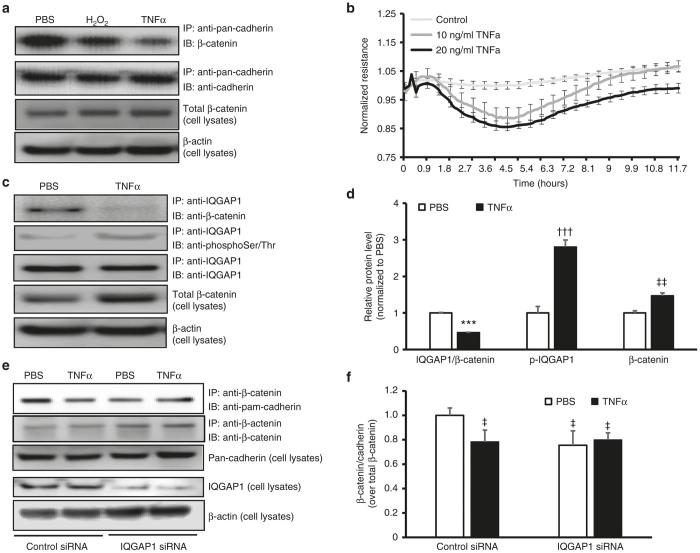Figure 5.
TNFα reduces RPE barrier integrity by a mechanism involving IQGAP1 interaction with β-catenin and phosphorylation. (a) Co-immunoprecipitation of junctional protein pan-cadherin and β-catenin and western blots of β-catenin and β-actin in retinal pigment epithelial (RPE) cells exposed to PBS, H2O2 (10 µmol/l), or human recombinant TNFα (20 ng/ml) overnight; (b) Electric Cell-substrate Impedance Sensing (ECIS) analysis of barrier resistance of RPE cells exposed to human recombinant TNFα (10 or 20 ng/ml) or control PBS for 12 hours; (c) and (d) coimmunoprecipitation of IQGAP1 and β-catenin or phosphorylation of IQGAP1 and western blots of β-catenin and β-actin in RPE cells exposed to TNFα (20 ng/ml) or control PBS for 5 hours (c, representative gel images and d, quantification of densitometry of C; ***P < 0.001 versus PBS of IQGAP1/β-catenin; †††P < 0.001 versus PBS of p-IQGAP1; ‡‡P < 0.01 versus PBS of β-catenin) and (e) and (f) coimmunoprecipitation of β-catenin and pan-cadherin and western blot of IQGAP1 and pan-cadherin in RPE cells transfected with IQGAP1 siRNA or control siRNA and treated with TNFα (20 ng/ml) or control PBS for 5 hours (e, representative gel images and f, quantification of densitometry of e; ‡P < 0.05 versus Control siRNA/PBS).

